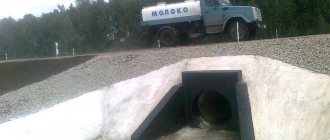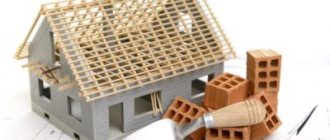Many city dwellers prefer to live not in a multi-storey building, but in a country house, away from the bustle of the city. Later, such a choice will bring the owner all the benefits of living in nature, but first he will have to go through serious procedural obstacles in order to obtain ownership of the land and the decision to begin building a private house. And at the beginning of this difficult path, the developer must clearly understand where to start building a house. This and many other important nuances of building a private house are discussed below.
Where to start building a house, preparation and next steps
At this stage, you will need to resolve a number of important issues: select a place for construction, determine the construction budget, purchase a cottage project, issue a building permit and select a contractor. All these issues are equal in importance, and everyone will have to pay a lot of attention.
Preparatory stage of construction
For those who do not know how to build a house correctly, experienced developers advise starting the process by purchasing a plot of land or concluding a long-term lease agreement. Next, a mandatory package of documents is prepared, the composition of which is determined by urban planning regulations. The list of documents in the package may partially change, based on the characteristics of the region and the number of floors of the building under construction.
When purchasing a plot of land, you should not completely trust the seller’s information; you need to check everything yourself.
Note! Immediately after completing the procedure for acquiring a land plot, you need to fence it. It is also important to allocate a place where the concrete solution will be prepared, waste will be stored and removed. This will make it possible to protect the area from litter.
Methods of obtaining
It is worth considering two main ways of obtaining permission to build a private house: standard and simplified.
The standard method of obtaining occurs if the construction of more than three floors is planned. The simplified scheme applies to a standard residential building, the number of floors of which is limited to three. First, a citizen needs to understand where to go with the package of documents. In the case of the construction of a residential building, he should go to the local government authority responsible for architecture and urban planning, which is located in the area where the site itself is located.
In general, the procedure looks like this.
- The citizen submits a package of documents to the relevant authority, which will issue the permit.
- State agency specialists review the submitted application and documents within 10 days.
- Upon expiration of the legal period, the applicant is issued either the permit itself or a document refusing to issue it with a clear justification of the reasons for such a decision.
- If the decision of the authority is positive and a permit is issued, construction work can begin.
How to correctly draw up a land donation agreement? What is the tax rate for an apartment and what does it depend on? Read more about this in our article.
Do you want to issue a deed of gift for a share of an apartment? The step-by-step procedure is described here.
Conducting geological and geodetic research on the site
Before building a house, it would be correct to study the properties of the soil on the site based on geological and geodetic studies, during which the following data is obtained:
- On the physical and mechanical characteristics of soil.
- Information about the geological structure of the earth.
- Level of location of groundwater.
- Soil strength.
- Chemical-corrosion potential of soil.
This information will help determine the location of drilling a well or constructing a well to supply water to the house, as well as choose a method for designing the future foundation.
Neighbors' rights
The peaceful coexistence of neighbors in individual housing construction, SNT and private household plots is regulated by law. Several rules must be followed:
- it is impossible for the shadow of any of your buildings or trees to fall on your neighbors’ property;
- The distances between neighboring objects given in the previous section of the article must be observed.
It is important to remember that almost all issues with neighbors can be resolved pre-trial. And the last resort for resolving disputes is judicial regulation.
Preparation of the project and its connection to the area
If the developer has chosen a standard project to build a house, it must be tied to the area. Therefore, the building is removed to its real size. This process is mandatory and is aimed at establishing the optimal location of a residential building on the ground, taking into account climatic parameters, soil characteristics and the allocation of boundaries of private households.
Since standard projects are generally not designed for seismic areas, when they are tied to a location, as a rule, it is not possible to increase the seismic resistance of a structure. Therefore, you will need to change the space-planning solution, the stages of building a house, or abandon the taken design documentation and choose another option that takes into account this important parameter.
The binding project must include two mandatory drawing sheets:
- Situation plan, M1:2000.
- General plan, M1:500.
The first sheet indicates the plan of the land plot on the construction site, and the second sheet contains the building site of the cottage with various auxiliary outbuildings and a garage. The fundamental point is the unmistakable location of the building on the land plot according to the cardinal directions, in accordance with the regulatory and technical framework.
Planning and zoning
You can start planning at the same time as completing the paperwork. To begin with, you should study the plot you have received in more detail. Go around it and examine the plants with buildings. Think about what is worth keeping and what is better to get rid of, what is missing, whether any plants require pruning of branches - and so on. If you have not yet made acquaintance with your neighbors, then it is time to do so. You can find out from your neighbors where to go in case of various types of incidents. It is also worth studying how garbage is removed, checking the quality of water, and examining the soil.
It is best to hire the services of a specialist to conduct a geodetic survey: he will determine the type of soil and water level, and draw up a relief plan. Based on the results of his work, it will be easier to decide whether something is worth rebuilding in the area.
Although the type of soil can be determined independently, many do not apply for research. The plants on the site will serve as a hint: if there is a lot of horsetail, plantain, and sparrow sorrel on it, the soil is acidic; coltsfoot, bindweed, meadow and creeping clover, fragrant chamomile love slightly acidic and neutral soils; stinging nettle grows on rich and fertile soil.
When planning, it is also worth considering the direction of the winds - determining which places are well protected from them, where the sun's rays most often fall. If the site is completely clear of buildings, you should immediately decide whether you will need a “temporary structure” on it, or whether you will immediately begin building a house.
Next, you can start drawing up a plan. The site must be divided into several mandatory zones: utility, garden, vegetable garden and recreation area. Select them and make a detailed plan with all the buildings that you will need. A landscape design specialist will help you arrange all the objects in the best way and draw up a plan - his services will be especially useful if the site has complex terrain that needs to be taken into account, or there are already many objects on it and you are going to completely reorganize it.
The plan should indicate communication routes, as well as the entrance. Since the entrance is quite wide, and the land allocated for it cannot be used for anything else, it is worth thinking through everything so that it does not go too deep into the yard.
When the plan is drawn up, it is worth working out plans for each zone separately and drawing them. When drawing up a plan, it is worth complying with the established requirements: this is the only way in the future it will be possible to register the house - for this you will need to collect a lot of documents, including compliance with all regulations on the site.
For example, a residential building must be at least 3 meters from the border of the site; light buildings for animals - at least 4 meters, other buildings - at least a meter. The location should be such that the buildings cast a shadow on the neighboring area as little as possible.
Trees and shrubs should also not grow close to the border: for the latter, the minimum distance from the trunk is one meter, for trees of medium height - two, and tall - four. Planting a hedge is allowed, but appropriate plants must be used for it - the main thing is that they do not form new shoots in the neighboring area.
If there is no centralized sewage system, the sanitary zone is required to be located at least 15 meters from residential premises, and the drains should be directed past the garden.
How to obtain a building permit
It is prohibited to build a house on a site without the consent of municipal authorities; such an object will be recognized in court as unauthorized, with its demolition and the imposition of financial sanctions on the developer. A building permit is an act of local government that guarantees the legality of the start of construction. Without such a document, further commissioning of the property and registration of ownership rights will be impossible.
The list of documents that the developer must submit to obtain a construction permit is established by law and the Town Planning Code:
- Applications for permission from the developer. The form can be downloaded from the government services portal.
- A document confirming ownership of a plot of land.
- Urban planning plan of the land plot.
- An approved house construction project and a phased construction plan.
Drawing up a notice of the start of construction, obtaining technical conditions for connecting to communications
A notice of the start of construction of a facility is a document according to which the developer notifies the regulatory authorities that it begins construction on a land plot according to the project. The application indicates passport data and information about the site and design characteristics of the object with a mention of the building material, for example, foam block.
The submission of such a notice by the developer does not give him the right to begin construction. It is necessary to wait to receive written confirmation from local authorities that the property complies with design characteristics and urban planning standards. Such a response must be received by the applicant no later than 7 days for areas of ordinary development and up to 20 days for historical buildings.
Attention! To provide a house with water, electricity and gas supply services, it will be necessary to connect intra-house networks to central utility networks. This right of the developer is regulated by the Rules for determining and providing technical conditions in accordance with Decree of the Government of the Russian Federation No. 83, adopted in 2006.
In order for the developer to have a basis for connecting external networks, he must obtain technical conditions from resource supply companies and fulfill them before putting the house into operation. Before submitting an application for specifications, supply organizations will need to know the volumes of resource consumption: water, electricity, gas, communications and heat.
Validity period of the permit
As paragraph 19 of Article 51 of the same code states, permission for the construction of individual housing construction
provided for a period of 10 years.
For all other objects, the rule applies according to which this document is valid for the period provided for by the project for the construction of a capital building.
For example, in Moscow and the Moscow region, the permit is valid for three years. Before this time, the corresponding facility must be put into operation.
This period can be extended, the law allows it.
This can be done for a maximum of 3 years, during which it will be necessary to complete the construction process and put the facility into operation.
What is needed for renewal?
Collect and submit a package of documents to the government agency:
- Previously obtained building permit.
- The applicant’s passport or documents certifying the registration of the legal entity.
- Report on the state of construction.
- Application for extension of time.
These documents must be submitted no later than 60 days before the expiration date of the current building permit.
Construction of the foundation for the building
Similar to other capital projects, the construction of a frame house requires the construction of a foundation. At the same time, it is inappropriate to build a powerful reinforced concrete foundation for a building whose standard service life is no more than 100 years, and when developing a basement, it will be necessary to take into account the level of groundwater.
The most common foundation for a frame house is considered to be a strip foundation, which is poured below the freezing point of the soil. Thus, it compensates for the movement of soil and makes it possible to proportionally distribute the load created by the house on the soil.
Table of the minimum depth of laying a strip foundation
| Soil freezing level, cm | Foundation level, cm | |
| Slightly heaving soils | Non-heaving soils with hard rocks | |
| > 240 | No | 150 |
| 140 — 240 | > 300 | 100 |
| 100 — 150 | 200 — 300 | 80 |
| < 100 | < 200 | 50 |
Pouring such a foundation has technological features:
- A necessary condition is considered to be reinforcement around the perimeter of the structure, and the reinforcement must be secured to each other using wire knitting.
- To make the foundation, only freshly prepared concrete mortar, grade M 200 and higher, is used.
- The foundation must stand before the construction of the frame.
- An integral process should be waterproofing the foundation.
Engineering Communication
The location of utilities on the site where it is planned to build a low-rise house for seasonal or year-round use is important. Let's take a closer look at the main points.
- It is allowed to have both a central cold water supply system
and an autonomous one. This also applies to sewers. When organizing any of the options for water supply and operation of wastewater, it is necessary to comply with the requirements of the following regulations: - SanPiN 2.1.4.1110;
- SP 30.13330;
- SP 32.13330.
- Sewage pipes
with a diameter of at least 15 cm must be laid underground deeper than 30 cm. - Heating in a private house and hot water supply
is carried out autonomously through a boiler (stove) and water fittings. The area of the room for the boiler is at least 5 square meters. m. - Gas supply
can be from individual sources (cylinders) or from a central gas pipeline. For autonomous gas supply, cylinders with a capacity of more than 12 liters must be placed in an extension or in a metal box behind the outer wall closer than 5 m to the entrance. Laying gas pipes into the foundation is not permitted. A gas boiler (if any) cannot be installed in a bathroom or living area. - Power supply wire supports
should not interfere with the passage of vehicles. The height of the wires to the house is above 2.75 meters, the distance from the centralized power grid to the building is no more than 25 m. Otherwise, the installation of an additional support pole will be required.
The CitySip company designs and builds turnkey houses from SIP panels in compliance with all construction standards on sites of any type of use: country houses, gardens, individual housing construction. Our specialists have up-to-date information on SNiP and other regulatory legislative acts. It’s easy to get a consultation or make an application for the design and construction of a cottage: call the numbers provided or leave a request on the website. Our managers will definitely contact you as soon as possible.
Construction of a house frame
The frame is a critical stage in the construction of this type of house. When installing it, it is recommended to use metal mounting elements or self-tapping screws, but not nails. The gap between the racks will depend on the width of the insulating material and finishing structures, otherwise the developer will need to install auxiliary racks at the junction points. The racks are made of timber 150x150 or 150x200, which is acceptable for the further installation of thermal insulation elements.
During the installation process, temporary jibs are installed to prevent the wall systems from being beveled in any direction. Vertical posts are reinforced with horizontal jumpers, which are attached with corners to prevent the formation of cracks and distortions. After all the racks are secured, the upper one is installed using the bottom strapping technology. To ensure the stability of building structures, the frame is secured with diagonal braces, and fencing systems for window and door openings are installed.
How to install a fence
According to the rules, a permanent fence can be built only after a cadastral examination has been carried out regarding the size of the site and its boundaries. Until this point, it is allowed to install a chain-link fence.
The fence is divided into two types: one protects from a public road (driveway), the other from neighbors.
Requirements for the fence:
- no clear height conditions have been established. As a rule, the following figures are taken into account: the height is no higher than 1.5 m between neighbors, and 2.2 m on the side facing the road. Often specific conditions are formed by local governments. Therefore, before installing a permanent fence, it is worth visiting the municipality and finding out the rules in force in this municipality;
- the fence and gate should not protrude beyond the cadastral markings;
- the minimum distance to a residential building is 1 m;
- if the gate is located close to a public road or driveway, then it must open inward without interfering with pedestrians and vehicles;
- the fencing design should not have elements that could potentially harm passers-by.
Façade finishing and primary interior work
Initially, they begin the external cladding of the house, and after that the internal finishing work. This rule is established to prevent the impact of atmospheric factors on the particle boards with which frame structures are sheathed.
When used for lathing wooden materials, they are treated with antiseptic solutions and fire retardants so that the wood is more resistant to the influence of a damp external environment and flame.
There are a number of recommendations that must be followed during the finishing work in a frame house:
- The finishing work of the rooms is carried out sequentially.
- The first room in which finishing will take place is chosen to be the one furthest from the front door.
- First, it is necessary to lay utility lines, and only after this is completed, they begin covering walls, ceilings, and installing floor materials.
- In a frame house, finishing work is carried out “from top to bottom”.
Additional Information! There is only one exception to this rule - suspended ceilings, which are installed after finishing the walls.
Dura lex sed lex "the law is harsh, but it is the law"
What will please the owner of a cottage plot in terms of additional buildings depends solely on the personal preferences of the landowner. However, experts note that most often sandboxes for children, swings, wells, bathhouses and garages are built on free territory. This applies to economy class. Entrepreneurs with a large income can afford not only separate buildings for gyms, stables, and a swimming pool, but also separate residential buildings for service personnel.
“Today, winter gardens are incredibly popular in cottage villages,” comments Andrey Bezbarov, head of the Penza press center . – This is due to the fact that Russia is a northern country, with long, cold winters in most regions.
Therefore, it is impossible for us to grow many plants in open ground, while a winter garden is ideal for these purposes. Sometimes winter greenhouses occupy territories reaching three hundred square meters. If we talk about the legal side of the matter, the construction of any buildings on the territory of the village is considered legal if there are no restrictions on construction.
A greenhouse or winter garden is a decoration for a country house and the opportunity to grow fresh flowers and plants all year round Source feellfeed.pw
Image matters
The expert also noted that the main condition for the construction of buildings in a cottage community is compliance with all SNIP standards, maintaining distances between buildings, neighboring areas and common roads. There are often situations when, when selling a plot of land in a formed village, the founders are already “on the shore” and voice a number of restrictions. These may be requirements for building materials or the architecture of future buildings.
An example from life : “We bought land this year,” said Olga Panova from Yekaterinburg . – The site was located in a cottage community, which, in turn, was built six years ago. When completing the transaction, we were immediately informed that in this village all buildings were made of brick.
So, no “wooden buildings”, Russian huts or other fairy-tale architecture, since such houses will stand out from the general concept of the village and spoil the appearance. In principle, we did not intend to build from wood, so we agreed to the conditions. The location is very good and the village is decent in terms of communications, a short distance from the city, which means there are jobs and sections for children.
How to clarify the boundaries of the site?
Land surveying is carried out by cadastral engineers. They are the ones who carry out all the necessary measurements and calculations. By law, every cadastral engineer is required to be a member of a specialized self-regulatory organization (SRO). SROs monitor the activities of their members and consider complaints from applicants if cadastral work was carried out with violations.
You can obtain information about a specific cadastral engineer on the Rosreestr website in the “State Register of Cadastral Engineers” section. It contains information about his special education, qualification certificate, and confirmation of his membership in the SRO. In addition, using the electronic register of cadastral engineers, you can find out about the results of a specialist’s professional activities.
A cadastral engineer visits the site and takes the necessary measurements. If there is a fence, then measurements are taken along it. If there is no fence, it is better to mark the corners of the area with pegs in advance. After reviewing the measurement results, the boundaries of the site must be agreed upon with the owners of adjacent plots.
After this work, the cadastral engineer draws up a boundary plan.











